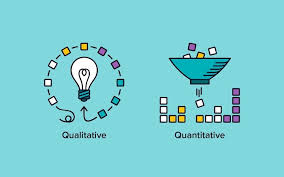Exploring the Depths: A Journey into Qualitative and Quantitative Research Methods

The Difference Between Qualitative and Quantitative Research
Research methods can be broadly classified into two main categories: qualitative and quantitative. Each approach offers unique insights and serves different purposes in the field of research.
Qualitative Research
Qualitative research focuses on exploring and understanding the underlying reasons, motivations, and opinions behind a particular phenomenon. It involves collecting non-numerical data such as interviews, observations, and open-ended survey responses. Qualitative research is descriptive in nature, aiming to provide a deep understanding of complex social phenomena.
Key characteristics of qualitative research include:
- Emphasis on context and meaning
- Subjective interpretation of data
- Flexible research design
- In-depth exploration of topics
- Small sample sizes
Quantitative Research
In contrast, quantitative research focuses on quantifying relationships, patterns, and trends through numerical data analysis. This approach involves collecting structured data through surveys, experiments, or statistical analysis of existing datasets. Quantitative research aims to test hypotheses and generalise findings to a larger population.
Key characteristics of quantitative research include:
- Emphasis on measurement and statistical analysis
- Objective data collection methods
- Rigorous research design with controlled variables
- Numerical data representation
- Larger sample sizes for generalisation
Combining Qualitative and Quantitative Approaches
While qualitative and quantitative research are often viewed as distinct methods, researchers can benefit from using a combination of both approaches in a study. This mixed-methods approach allows for a comprehensive understanding of complex phenomena by triangulating different sources of data.
By integrating qualitative insights with quantitative data analysis, researchers can validate findings, explore relationships in-depth, and provide richer interpretations of their results.
In Conclusion
Qualitative and quantitative research play complementary roles in the research process. Understanding the strengths and limitations of each approach is essential for conducting rigorous and insightful studies across various disciplines.
7 Essential Tips for Integrating Qualitative and Quantitative Research Methods
- Qualitative data involves non-numerical insights such as opinions, behaviours, and experiences.
- Quantitative data includes numerical information that can be measured and analysed statistically.
- Use qualitative methods like interviews and focus groups to explore complex issues in depth.
- Employ quantitative techniques such as surveys and experiments to gather measurable data.
- Qualitative analysis often involves identifying patterns or themes within the data.
- Quantitative analysis typically involves using statistical tools to test hypotheses or identify trends.
- Combining both qualitative and quantitative approaches can provide a more comprehensive understanding of research questions.
Qualitative data involves non-numerical insights such as opinions, behaviours, and experiences.
Qualitative data provides valuable non-numerical insights into various aspects such as opinions, behaviours, and experiences. By capturing the richness and depth of human perspectives, qualitative data offers a nuanced understanding of complex phenomena that cannot be fully captured through numerical analysis alone. Through methods like interviews, observations, and open-ended surveys, researchers can delve into the subjective interpretations and meanings attached to different phenomena, enriching our knowledge and understanding of the world around us.
Quantitative data includes numerical information that can be measured and analysed statistically.
Quantitative data comprises numerical information that is quantifiable and amenable to statistical measurement and analysis. This type of data allows researchers to apply statistical methods to identify patterns, trends, and relationships within the dataset. By quantifying variables and measuring them numerically, researchers can draw objective conclusions and make generalisations based on the statistical analysis of quantitative data.
Use qualitative methods like interviews and focus groups to explore complex issues in depth.
Employing qualitative methods such as interviews and focus groups can be invaluable when delving into intricate and multifaceted issues. These approaches allow researchers to engage with participants directly, gaining nuanced insights and perspectives that quantitative data alone may not capture. By facilitating open-ended discussions and exploring underlying motivations, qualitative methods enable a deeper understanding of complex phenomena, contributing to richer analyses and more comprehensive research outcomes.
Employ quantitative techniques such as surveys and experiments to gather measurable data.
Employing quantitative techniques such as surveys and experiments is essential for gathering measurable data in research. Surveys allow researchers to collect numerical data from a large sample of participants, providing statistical insights into trends and patterns. Experiments, on the other hand, enable researchers to manipulate variables and establish causal relationships between factors. By utilising these quantitative methods, researchers can obtain objective and quantifiable data that contribute to a deeper understanding of the research topic.
Qualitative analysis often involves identifying patterns or themes within the data.
In qualitative analysis, researchers frequently engage in the process of identifying patterns or themes within the data. This approach allows for the exploration of underlying relationships and trends that may not be immediately apparent, leading to a deeper understanding of the subject under study. By recognising and interpreting these patterns or themes, researchers can extract valuable insights and generate rich narratives that contribute to the overall richness and depth of qualitative research findings.
Quantitative analysis typically involves using statistical tools to test hypotheses or identify trends.
Quantitative analysis in research often entails the application of statistical tools to test hypotheses or uncover patterns and trends within data sets. By utilising quantitative methods, researchers can quantify relationships, measure variables, and draw statistically significant conclusions based on numerical data. This analytical approach provides a structured framework for hypothesis testing and allows for the objective evaluation of research questions, contributing to the robustness and validity of study findings.
Combining both qualitative and quantitative approaches can provide a more comprehensive understanding of research questions.
By combining both qualitative and quantitative approaches in research, investigators can gain a more comprehensive understanding of the research questions at hand. Qualitative methods offer insights into the nuances, motivations, and contexts surrounding a phenomenon, while quantitative methods provide statistical validation and generalizability to the findings. Integrating these two approaches allows researchers to triangulate data sources, validate results, and offer deeper interpretations that enrich the overall understanding of complex research topics.
